| 1 | Snake frazzles CCTV camera |
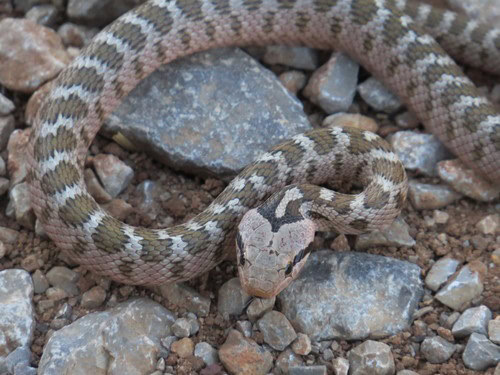
It was October 2016 when repairmen near the Azerbaijan capital of Baku were summoned to repair a CCTV system. The security cameras were supposed to be guarding a tomato farm, yet had mysteriously gone black.
The workers opened the control box, and were surprised to find that a snake had slithered in, and apparently short-circuited the electrics. The snake was seen peeping outside a small hole, like it knew it had done wrong. The snake seemed unharmed, with no signs of electric shock.
A technician filmed the snake in the control box, and uploaded it to social media. The video soon went viral, with comments feverishly speculating over the exact species. While we can’t be sure, the snake’s beige underlay and rapidly alternating black checkers lead us to believe that it’s a Trans-Caucasian ratsnake (Zamenis hohenackeri), a common species in Azerbaijan, which is non-venomous and had no chance of killing the workers. Another possibility is the non-venomous eastern montpellier snake (Malpolon insignitus). The ultimate fate of the snake was never revealed.
| 2 | World’s biggest snake caught? |

No matter how advanced society becomes, tales of giga-serpents will never stop flowing, and nor would we want them to. April 2016’s edition occurred in Malaysia, when a female reticulated python slithered into the construction site of a flyover, on the scenic holiday island of Penang. Headlines soon burst onto screens that the python measured 8 metres and weighed 250kg. Images were released showing a very chunky snake indeed, requiring 5 government men with blue uniforms and yellow hard hats to hold her.
Government officials had taken 30 minutes to trap the snake. If the estimates were true, the Malaysian monster would exceed the longest confirmed wild reticulated python (and snake) on record, a 6.95 metre Indonesian individual that ate a sunbear in 1999.
Unfortunately, before western scientists could arrive with measuring instruments, the snake died. She had laid one egg hours after being captured. “Maybe she committed suicide. Maybe she felt threatened so she killed herself” speculated an officer with Malaysia’s Civil Defence Force. However, footage had shown workers kicking the python, and even light-heartedly placing a noose around its neck. The snake certainly looked huge in images, but the chance to break the official wild record was now lost. Two other members of the department reported her length at 7.5 metres before her death. The mystery will remain.
| 3 | Human eyesight and snakes |
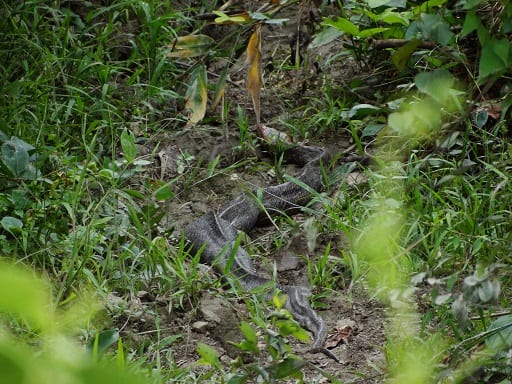
According to a 2016 study, sensitivity to snakes is coded into human vision. Two Japanese scientists developed a system called Random Image Structure Evolution, which involved pictures of 4 animals: snakes, birds, cats and fish.
Each animal had 20 different images, on scales of blurriness to clarity, in a way that was designed to mimic camouflage in undergrowth. Human volunteers were made to view the images and adjust until they were recognisable.
With the snake images, participants usually required the 6th to 8th image to make a correct ID. With all other animals, they generally succeeded at image 9 or even 10. Most importantly, the images closely replicated conditions snakes would be found in in the wild.
The scientists concluded that our eyes are uniquely sensitive to serpents, to function as an alarm system designed to send our brains an instant warning. In fact, the mere existence of snakes may have spurned our eyesight to become sharper and more discerning. While our sense of smell pales next to a bear’s, which can sniff out a familiar dumpster from over 10 miles away, most great apes have strong eyesight. The theory that snakes triggered this enhancement over 10 million years ago is widely dubbed “snake detection theory”.
| 4 | Avoid stressed out cottonmouths |
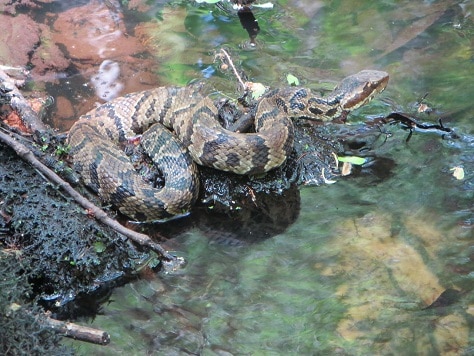
It’s common knowledge that your boss is more likely to launch a 5 minute long verbal tirade during the office’s busy season. A 2016 study revealed that cottonmouths aren’t too dissimilar, as scientists measured their blood for the stress hormone corticosterone, and found a correlation with likelihood to strike.
Scientists prowled the beaver marshes and cypress swamps of Alabama to search for cottonmouths. At each encounter, they followed the same system. Firstly, the scientists stood 1 metre away to record their defensive responses. Then they seized them with steel tongs for 15 seconds to monitor any changes, before placing the cottonmouth in a tight plastic tube and extracting blood samples from their tail. Then they placed each cottonmouth inside a 5-gallon bucket for 30 minutes, to increase their stress levels due to confinement, before taking another blood sample.
Surprisingly, there was no correlation between aggression in the snakes deliberately stressed, no increased strike rates. However, the cottonmouths with higher pre-existing stress hormones were significantly more aggressive. It was their baseline level of stress that was important. If a cottonmouth is already relaxed, then provoking them may not be enough – this could explain why copperheads (their close relative) sometimes don’t react even after being stepped on.
The study also found that cottonmouths are less fearsome than feared. Only 11 of the 32 cottonmouths struck at researchers during their first encounter, despite them purposefully standing 1 metre away.
| 5 | Dog saves 7 year old girl |
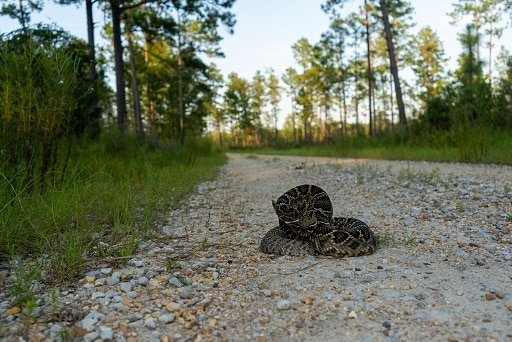
The eastern diamondback causes the most snakebite deaths in Florida, and ties with its western cousin nationally. Having a dog may be a defence against this fate, as the Deluca family learnt in 2016.
Molly and her German shepherd Haus were inseparable, after the family acquired the dog from a rescue shelter. When Molly met a diamondback in their backyard one day, Haus instantly roused to action. He jumped between snake and girl, and repeatedly moved forwards and backwards, as though trying to scare the snake away.
Haus succeeded, though soon began bleeding. When his leg was shaved in hospital, three fang puncture marks were revealed. Haus was treated with antivenom and painkillers, and survived, although was believed to have suffered kidney damage. His muscles were damaged by the bite, but he managed a short walk after a few days. A fund-raising website was established to pay for the dog’s medical costs, and rapidly reached $50,000. Molly escaped without bite, and gave her opinion on her pooch protector: “He’s a cute dog. I like to smoosh his face“.
| 6 | Man empties 285 snakes |
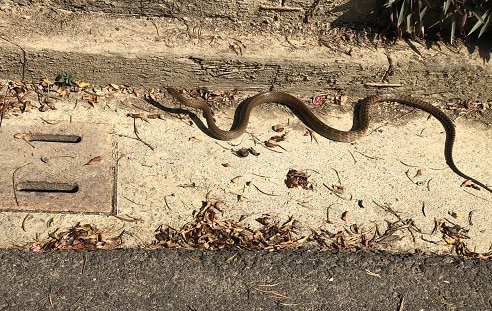
In 2016, a video went viral of an Indian man emptying 285 snakes onto a remote rural road. The video reached 1.5 million views, and simply showed the man turning his sack upside down and allowing the snakes to fall out. The video was taken in the Panchmadhi forest near Bhopal, India. Rather than a zealot determined to spread snakes everywhere, the man was a professional snake catcher called Salem Khan, known locally as Saleem the snake man.
Over his 30 year career, Khan claimed to have released 220,000 snakes into the jungles of Panchmadhi. On the average day, he captured 25-30 snakes in the Bhopal region, including in government ministers’ offices. However, instead of killing them, or even selling their skins to luxury fashion houses, Salem released them into the woods. Viewer discretion is advised for any ophiophobe, as the video shows him release a writhing mass of snakes more typically found in a circus pit or Egyptian tomb. Khan stuck his hands into the pulsating pile, and attempted to spread the snakes out.
Ultimately, it took mere seconds for the snakes to disperse and slither into the undergrowth for freedom, each covering a different angle in a 360 degree radius. Salem chose to release them during evening so that the ground was cooler. It’s hard to determined the species, but the majority were said to be ratsnakes, probably the harmless yet large oriental ratsnake (Ptyas mucosa).
| 7 | Indonesian singer bitten while live |
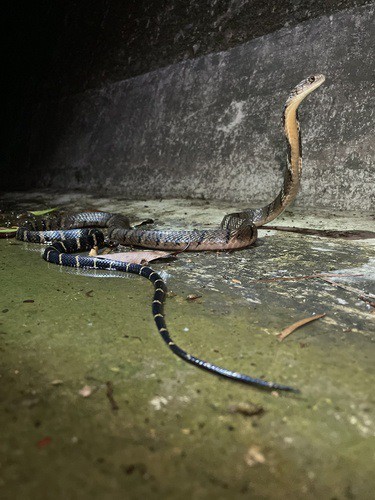
Our next story has a tragic ending, and a warning never to underestimate the darker forces of nature. Irma Bule was a popular singer in Java, Indonesia’s most populous island, who specialised in the genre of Dangdut. This originated in the 1980s, was once banned by the Indonesian government, and is still frowned upon by Islamic fundamentalists. Bule’s gimmick in the crowded Dangdut genre was draping snakes around herself, which she had begun three years earlier. During a concert in west Java, Bule was handed a king cobra called Rianti, which she was assured was defanged. She sensually draped the king cobra around her neck as usual, but accidentally stepped on the king cobra’s tail mid-concert. In response, it sank its fangs into her thigh, which was captured on film.
Bule refused medical treatment, and kept singing and dancing as though nothing had happened. It briefly seemed like she had resisted its venom. But 45 minutes later, she was laughing and joking backstage, when she suddenly start vomiting, having seizures and collapsed. Bule was transported to the emergency room, where she was quickly pronounced dead. Police began an investigation, and Bule’s mother was still waiting for answers from the organisers.
Meanwhile, Bule left behind a husband and three children below aged 10. King cobra antivenom is very effective as of 2024, and if Bule had accepted a vial, she likely would have survived.
| 8 | New African adder discovered |
2016 saw yet another viper added to the 200+ worldwide, this time found in a small pocket of Ethiopia’s mountainous core. This was part of the same Bitis family as Africa’s ubiquitous puff adder, yet far rarer.
Technically, the snake had been discovered in the late 1960s, but nobody realised, as the specimen had been stored in a museum ever since. In 2013, researchers exploring Ethiopia’s Bale Mountain national park spotted a strangely dark viper disappearing into the undergrowth, in the biodiversity-rich Harenna Forest. This is a hub of many rare frogs, and is the last remaining habitat of the endangered Ethiopian wolf.
This one fleeting glance spurred the researchers to action, and they reexamined the old museum snake, spotting clear differences in skull structure to other vipers. The patterns were dense black with patterns of many thin white lines, similarly to the Arizona black rattlesnake. There were also subtle differences in scale counts. This enabled them to announce an all new snake: the Bale Mountains adder (Bitis harenna).
The new snake’s venom wasn’t analysed, but assumed to be equally dangerous to their Bitis adder cousins. The new viper was already deemed to be under threat due to cattle grazing and deforestation. Another rare Ethiopian member is Bitis parviocula, the Ethiopian mountain adder. However, this looks completely different, with a green underlay with round black blotches.
| 9 | The genes that make snakes long |
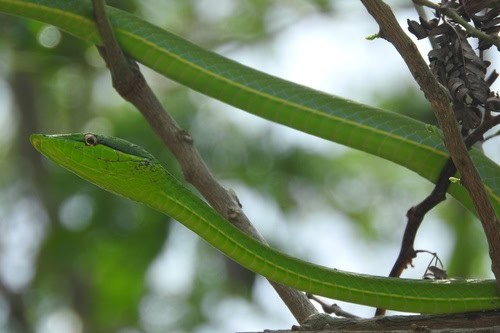
Gorillas have genes that endow them with super strength, humans have genes that give us intelligence, and somewhere in snakes are genes which massively extend their length. Scientists already knew about a gene in mice called Gdf11, which controlled length. When this gene was overactive, in a select few mutants, it produced a creature worthy of Dr Moreau’s island: a bizarrely elongated mouse. These mice also had clusters of cells at their tail.
In nature, creatures can become elongated either by extending individual vertebrae, such as a giraffe’s neck, or by increasing the quantity of vertebrae, like a swan’s. The scientists next identified a similar gene called Oct4, present in many vertebrates, including mice and snakes. The scientists tested whether Oct4 was overexpressed during the embryonic development of snakes, and as expected, it was. Oct4 remained active for longer periods in snakes, due to its position next to a cluster of DNA that kept the genetic switch on.
The scientists then manipulated the Oct4 gene in mouse embryos, and found that they too become longer. Specifically, Oct4 worked by increasing the quantity of vertebrae on the lower body, rather than extending each one’s length.
The study wasn’t just an intellectual curiosity, but was believed to offer clues in the future for regenerating spinal patients.
| 10 | Bullet train screeches to a halt |

Snakes on a train is a surprisingly common occurrence worldwide, whether crossing the tracks or nestled snugly in an overnight carriage. In 2011, a Japanese bullet train was brought to a screeching halt near Kyoto after passengers noticed a Honduran milk snake. Despite its red-black bands, this is a harmless species.
Meanwhile, 2016 saw a new incident when a 30cm (1 inch) snake was spotted poking through a gap between the seats. The only animals allowed on bullet trains are small fish and birds, yet here the snake was. Somehow, it had gone unnoticed for nearly an hour. The snake wasn’t venomous, as it bore no resemblance to Japan’s mamushi or habu. Its brown appearance and occasional black patterns led people to believe it was a juvenile ratsnake.
The train was forced to stop between Tokyo and Hiroshima, where police captured the serpent stowaway. Despite announcements on loudspeakers informing passengers of an escaped pet, no owner came forward. The reputation of the hyper-punctual bullet train was saved, as somehow, it still arrived in Hiroshima on time.
